Standards Worldwide
Standards Worldwide
Phone +49 30 58885700-07

Standard [CURRENT]
ASTM F 748:2025
Standard Practice for Selecting Biological Test Methods for Materials and Devices
- German title
- Übersicht über biologische Prüfverfahren für Substanzen und Geräte
- Publication date
- 2025
- Original language
- English
- Pages
- 9
- Publication date
- 2025
- Original language
- English
- Pages
- 9
- DOI
- https://dx.doi.org/10.1520/F0748-25
Product information on this site:
Quick delivery via download or delivery service
Buy securely with a credit card or pay upon receipt of invoice
All transactions are encrypted
Short description
1.1 This practice describes biological test methods (as listed in 2.1 ) which may be used in support of a biological evaluation of materials and medical devices according to end-use applications. Biological evaluation is a component of a broader safety evaluation and is conducted within an ISO 14971 risk management framework. ISO 10993-1 sets out the general principles and requirements for such an evaluation. A biological evaluation conducted according to ISO 10993-1 requires a consideration of the composition of the medical device and the review of pre-existing information pertinent to biological risks. In many cases this pre-existing information will be sufficient to establish safety without a need for additional testing. Only where existing information is insufficient it may be necessary to conduct further testing (see ISO 10993-1). The purpose of this document is to provide guidance on available and applicable test methods to support such testing activities if they are required. 1.2 The reader is cautioned that the area of biocompatibility testing is a rapidly evolving field, and improved methods are becoming available continuously, so this practice is a guideline. A thorough knowledge of current techniques and research is critical to a complete evaluation of new materials and medical devices. 1.3 Biological evaluation of materials and medical devices for human application is discussed. Tests include those performed on materials, final finished medical devices, and extracts. The current state of the art is included for all test procedures described. 1.4 The biocompatibility of materials used in single or multicomponent medical devices for human use depends to a large degree on the particular nature and duration of tissue contact during intended use. It is not possible to specify a set of test methods which will be necessary and sufficient to establish biocompatibility for all materials and applications. Because biological reactions caused by a material or a medical device can have different implications or raise different safety concerns depending on the type and duration of tissue contact of the medical device, each application must be evaluated for biocompatibility and any associated testing on its own merit. 1.5 The evaluation of tissue-engineered medical products (TEMPs) may, in some cases, involve different or additional testing beyond that conducted on non-TEMPs-based materials and medical devices. Where appropriate, these differences are discussed in this practice and additional tests described. For additional information, see reference standards published under the jurisdiction of the applicable TEMPs Subcommittees of F04. 1.6 The ethical use of research animals places the obligation on the individual investigator to determine the most efficient methods for performing the necessary testing without undue use of animals. Where adequate prior data exists to substantiate certain types of safety information, these guidelines should not be interpreted to mean that testing should be unnecessarily repeated. Refer to ISO 10993-2 for additional information. 1.7 This standard does not purport to address all of the safety concerns, if any, associated with its use. It is the responsibility of the user of this standard to establish appropriate safety, health, and environmental practices and determine the applicability of regulatory limitations prior to use. 1.8 This international standard was developed in accordance with internationally recognized principles on standardization established in the Decision on Principles for the Development of International Standards, Guides and Recommendations issued by the World Trade Organization Technical Barriers to Trade (TBT) Committee.
ICS
07.080
DOI
https://dx.doi.org/10.1520/F0748-25
Also available in
Loading recommended items...
Loading recommended items...
Loading recommended items...
Loading recommended items...
